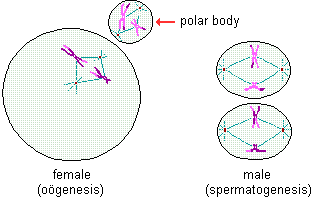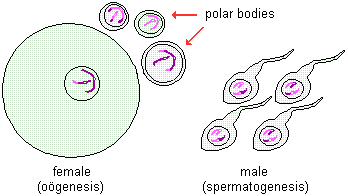The Anthropology Tutorials website will be taken offline on January 9, 2026.
Due to federal accessibility requirements taking effect in 2026, we will be removing this site. If you use materials from this site in your courses or research, please seek alternative resources.
Meiosis
Close Up
As in the case
of mitosis, the chromosomes replicate during an interphase
resting period when they are an undifferentiated mass. At the beginning
of the first stage of meiosis, prophase I, the
chromosomes contract and become visible. These doubled chromosomes then come
together in homologous pairs. Breakage of the ends of chromatids
usually occurs at this time,
followed by crossing-over, which results in
chromosomes with new combinations of genes.
 |
Interphase to prophase I
|
By the end of prophase I in ogenesis
, the immature ova cells that are being produced are referred to as
primary ocytes.
Before birth, human females produce approximately seven million primary ocytes that are
stored in their ovaries for future use.
During
metaphase I, all of the doubled homologous chromosome pairs
line up along the midline of the cell between the two centrioles.
 |
Metaphase I
|
1st
Division (Reduction Division)
During
anaphase I, the homologous chromosome pairs separate and are
pulled to opposite poles of the cell by spindle fibers attached to the centrioles.
 |
Anaphase I
|
This first cell
division process is completed during telophase I.
Separate nuclear membranes form. In ogenesis,
the cell membrane then begins to pinch inward to enclose the two new cells with an unequal
division of the cytoplasm. The larger one, containing about 95% of the cytoplasm, is a
secondary ocyte. It potentially will go on to become an ovum. The smaller cell is
a polar body which is not reproductively functional and which will ultimately be reabsorbed.
In spermatogenesis, telophase I results
in two cells with equal volume.
 |
Telophase
I
|
The cell division
during this phase (telophase I) is a reduction division. That is to say, the
resulting cells have only one of each pair of doubled homologous chromosomes. In the
case of humans, this new haploid number is 23. The original
diploid number
was 46.
2nd
Division
The second
division process occurs in metaphase II. It
begins with the chromosomes once again lining up on the equatorial plane of the cells,
equidistant between the two centrioles. The still doubled chromosomes then split at
their centromeres and the single chromosome strands migrate to opposite sides of the cell.
 |
Metaphase II |
The
result of this last division in ogenesis is the production of one ovum and two
more non-reproductively functional polar bodies. In spermatogenesis, four sperm
cells are produced.
 |
Culmination of meiosis
|
Copyright 1997-2012 by Dennis
O'Neil.
All rights reserved.
illustration credits





